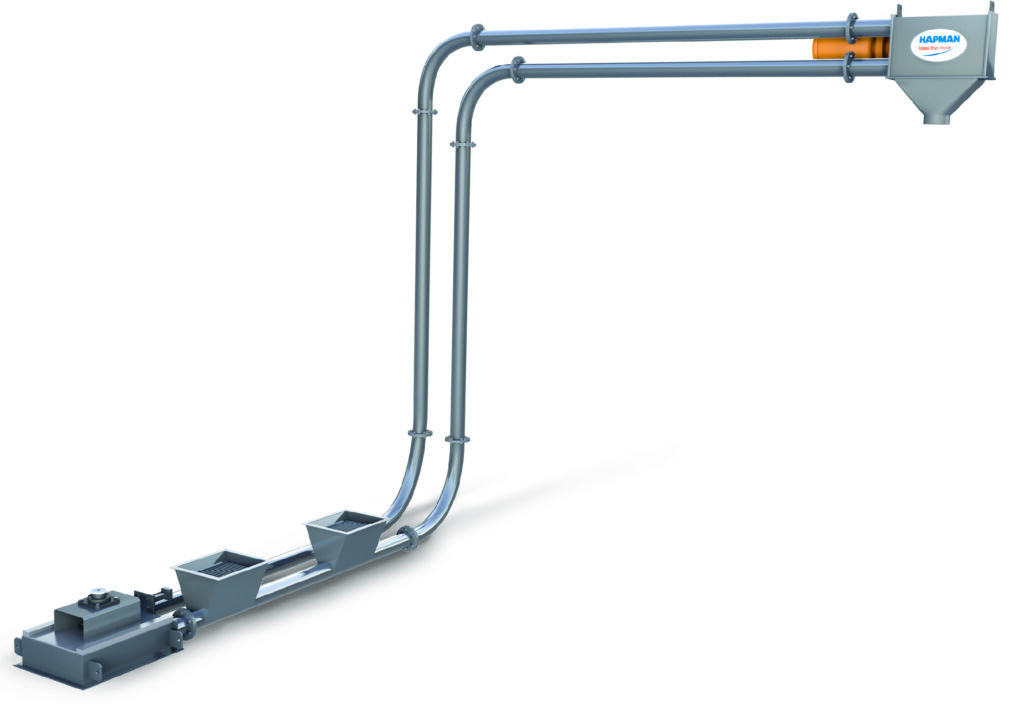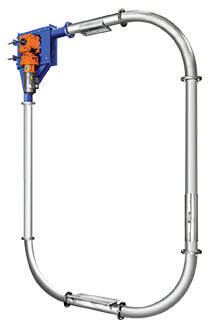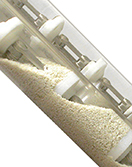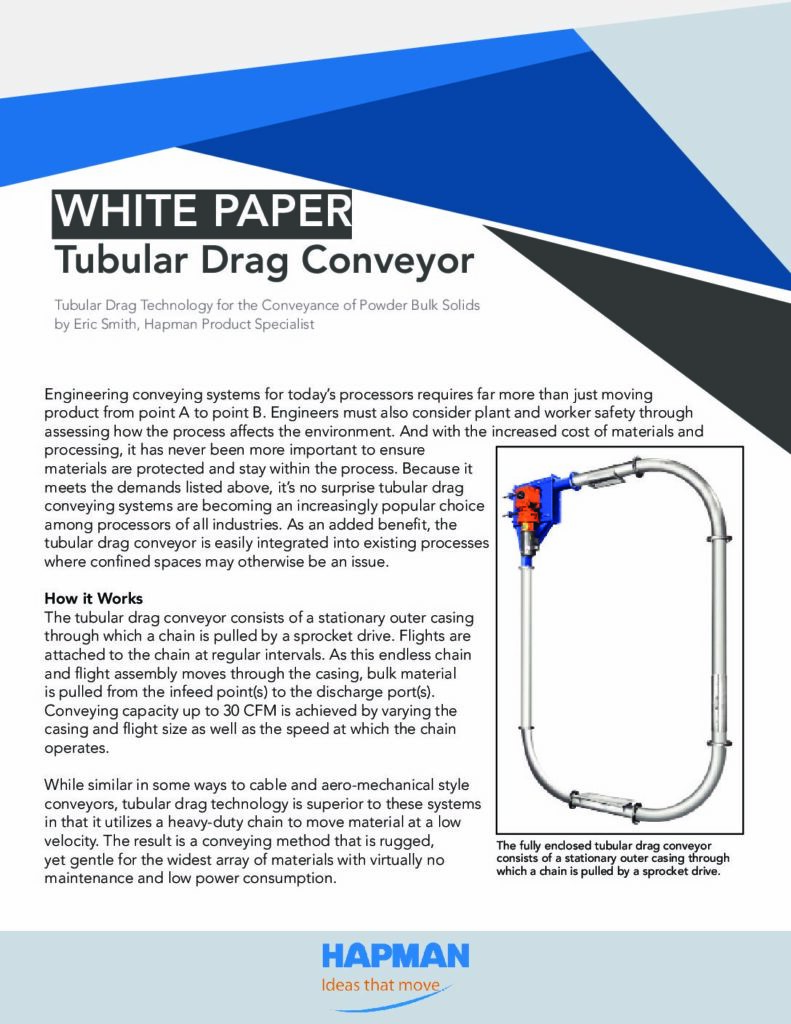
CHALLENGE
Engineering conveying systems for today’s processors requires far more than just moving product from point A to point B. Engineers must also consider plant and worker safety through assessing how the process affects the environment. And with the increased cost of materials and processing, it has never been more important to ensure materials are protected and stay within the process.
In today’s manufacturing landscape, creating efficient conveying systems goes beyond simply moving items from one location to another. Ensuring plant and worker safety and considering the impact on the environment are crucial factors for engineers. Additionally, with rising costs and the need to protect materials throughout the process, a reliable solution is essential.
That’s why tubular drag conveying systems are gaining popularity among processors in various industries. Not only do they meet these demands, but they also offer the advantage of seamless integration into existing processes, even in confined spaces.
HOW IT WORKS
 The tubular drag conveyor consists of a stationary outer casing through which a chain is pulled by a sprocket drive. Flights are attached to the chain at regular intervals. As this endless chain and flight assembly moves through the casing, bulk material is pulled from the infeed point(s) to the discharge port(s). Conveying capacity up to 50 CFM is achieved by varying the casing and flight size as well as the speed at which the chain operates.
The tubular drag conveyor consists of a stationary outer casing through which a chain is pulled by a sprocket drive. Flights are attached to the chain at regular intervals. As this endless chain and flight assembly moves through the casing, bulk material is pulled from the infeed point(s) to the discharge port(s). Conveying capacity up to 50 CFM is achieved by varying the casing and flight size as well as the speed at which the chain operates.
While similar in some ways to cable and aero-mechanical style conveyors, tubular drag technology is superior to these systems in that it utilizes a heavy-duty chain to move material at a low velocity. The result is a conveying method that is rugged, yet gentle for the widest array of materials with virtually no maintenance and low power consumption.
LOW SPEED ENSURES MATERIAL INTEGRITY, MINIMAL ENERGY CONSUMPTION
The typical tubular drag conveyor is operated by a single, low-horsepower electric motor, making it one of the most energy efficient methods of conveying. The slowmoving, positive displacement action of the chain assembly is ideal for handling friable and/or blended materials without separation or degradation. The slow movement also assures long conveyor life, dependable service and minimal noise levels with the ability to operate continuously or intermittently.
FULLY ENCLOSED, SEALED DESIGN PROTECTS MATERIAL AND WORKERS
The single most important feature of this conveyor is its fully enclosed construction, which can be guaranteed with male/female ends and gaskets for each section. This design effectively protects the product being conveyed from contamination from the outside atmosphere as well as protects the plant and the worker from the product. It is also highly effective at containing odors. As such, tubular drag conveyors are successful in handling an increasing number of hazardous materials.
In order to eliminate the reaction that can occur when material is exposed to the atmosphere, the tubular drag conveyor frequently operates under an inert purge. Because there is no air volume added to the system, tubular drag conveyors are ideal for moving hygroscopic materials either with or without dry air or inert gas purge. This also eliminates costly product/air separation equipment at the discharge points or a baghouse filtration system.
UNLIMITED CIRCUITRY OPTIONS
 Because of its flexible chain, custom-made conveying sections and casing bends, virtually unlimited variations of the conveyor circuit is possible. As a result, tubular drag conveyors are particularly well-suited for installation within existing processes that require bypassing obstacles that would interfere with the path of other conveyors.
Because of its flexible chain, custom-made conveying sections and casing bends, virtually unlimited variations of the conveyor circuit is possible. As a result, tubular drag conveyors are particularly well-suited for installation within existing processes that require bypassing obstacles that would interfere with the path of other conveyors.
Systems can transfer materials up to 400 feet (122 meters) and involve multiple changes in direction. Numerous inlet hoppers may be incorporated into a single conveyor to flood feed the unit as the chain assembly passes each opening. Likewise, the conveyor can have multiple discharge points. As such, a single tubular drag conveyor can replace multiple conveyors.
To provide selective discharge points with circuits that include multiple discharge points manually or pneumatically operated gates may be used. While conventional knife gates can be used for this purpose, it is more practical to use a self-cleaning discharge gate. The lower portion of the conveyor casing is cut away and reattached into position to open and close the discharge gate. Most materials will flow freely from the discharge of the tubular drag conveyor. For sluggish or sticky materials, a special chain vibrator can be used to aid in discharge.
Installation can be simplified with slotted flange connections that offer a wider range for bolt placement. As referenced earlier, use of male/female ends can assure proper alignment of the circuit with a tight seal.
MATERIAL CONSTRUCTION OPTIONS
 Just as the tubular drag circuit can be custom configured to virtually any circuit shape, a wide variety of materials are used in the conveyor components to meet the unique application and plant layout demands.
Just as the tubular drag circuit can be custom configured to virtually any circuit shape, a wide variety of materials are used in the conveyor components to meet the unique application and plant layout demands.
The casing can be manufactured of carbon or stainless steel pipe in sizes ranging in diameter from 3 to 12 inches (76 to 305 millimeters) or greater and utilize special liners, when required. Casing sections are supplied in lengths as required by the conveyor path.
Circular flights are available in UHMW polyethylene, cast iron, ductile iron, nylon or stainless steel. However, any number of materials as required to meet the unique needs of the material being conveyed can be used, including Tyvar® H.O.T. premium UHMW polyethylene.
All tubular drag conveyor manufacturers utilize round link chain as the basic chain style because it is less prone to fatigue, wear and stretch than steel cables. As wear occurs in the link and pin chain, individual parts may be replaced, which is not the case with a cable-type conveyor. In addition, round link chain offers a good strength-to-weight ratio and is flexible enough to work with complex conveyor circuits.
However, only Hapman employs three additional chain styles including rivetless, seal-pin and uni-seal. The multiple chain options afford Hapman the ability to custom engineer a tubular drag conveyor for a wider array of applications.
CONCLUSION
Protection of materials, people and plant; lower operating and maintenance cost, easy installation around existing equipment; and the ability to gently handle material combine to make tubular drag conveyors an increasingly popular choice for today’s processors.
